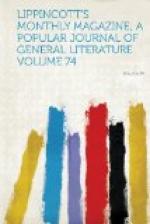as masterpieces styling themselves simply “stone-cutters.”
The contract is a long document, consisting of twenty-one
clauses, the greater number of which are occupied
with the most minute and detailed specification of
the work to be done. It is to be executed “according
to the model made by the said Bino, changing it or
keeping it as it is according to the will of the fathers”
(the monks of St. Peter’s), “so as not
to change the form and substance of the model.”
The prices agreed to be paid for each stall in the
choir, with its arch above it, is ten golden ducats,
which, allowing for the change in the value of the
precious metals, may be considered to be about equal
to three hundred and seventy-five dollars at the present
day. The price does not seem by any means a small
one. But Signor Rossi’s researches have
elsewhere shown that it is a mistake to suppose that
the renowned professors of any branch of art were
poorly paid in those days. The very reverse was
the case. It would not be interesting to the
reader to give him the details of the work which Maestro
Bino bound himself to execute, but some of the stipulations
must be mentioned, because they curiously illustrate
the life of the times. The convent is to furnish
all the wood—that which is required for
the work itself, as well as all that may be needed,
planks, scaffolding and the like, for the putting
of it in its place. “
Item. We give him
rooms to work in and to sleep in and to cook in, as
well as beds furnished with bedclothes.
Item.
Maestro Bino binds himself not to undertake any other
work till the choir is wholly finished and put up,
and he engages to do all the work within the walls
of the convent. He is bound to keep four men
at work under him, and more if necessary.”
The work is to be completed within two years should
no impediment intervene by death or grave and manifest
illness. The convent undertakes to furnish money
from time to time as needed for the pay of the journeymen,
and fifty ducats beforehand for the hiring of assistants
and other necessary expenses.
Maestro Bino went to work at once, and on the 15th
of that same April had from the convent what seems
the very large sum of ten florins and eight soldi
for glue. But, after all, this Maestro Bernardino
di Luca was not the author of the exquisite carvings
which people go to Perugia to look at at the present
day. A very “grave and manifest infirmity”
did intervene to prevent the execution of the work,
for on the 19th of the following August, Maestro Bino
discharged his workmen on account of the plague, which
had begun to devastate Perugia; and there is reason
to think that the maestro himself perished by it,
for after that last entry the name of Bernardino di
Luca vanishes into the abyss of darkness, and is no
more heard of, and shortly afterward we find the convent
entering into a new bargain with another maestro for
the execution of the work. This was Maestro Stefano
de Antoniolo da Zambelli of Bergamo, who agreed with




